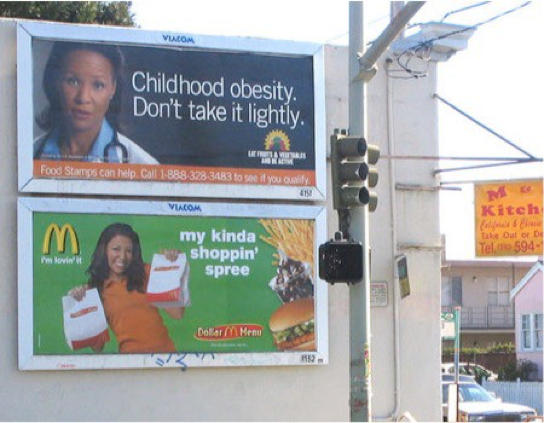
Share On Social!
You know junk food marketing to Latino kids is a problem and degrades Latino kids’ health.
But how do you communicate this issue to others?
A new framing brief by the Berkeley Media Studies Group (BMSG) can help you communicate more effectively and frame the targeted marketing of junk food to children of color as a health equity issue.
Understanding and communicating effectively about how junk food companies specifically target Latino children is a critical step toward action and achieving health equity.
Targeted Marketing is a Health Equity Issue
Targeted marketing of junk food to Latino children is a major obstacle because food and beverage companies aggressively target Latinos in their communities and schools.
California passed historic legislation this year to ban schools from marketing unhealthy foods to help students and parents choose healthier foods.
While this is a big positive step, TV and digital marketing of unhealthy foods is particularly problematic today.
For example, Latino preschoolers saw 23% more sugary drink ads on Spanish-language TV in 2013 than 2010, according to a research review from Salud America!.
Also, researchers recently found several baby formula companies use social media to tap into parents’ emotions by pushing parenting tips, freedom of choice, or “aligning themselves with parents’ dream for their children.” Remember baby food marketing to Latino parents does not align with expert opinion, like the American Academy of Family Physicians and the American Academy of Pediatrics.

Latino kids ages 6-17 also were more likely than their non-Latino peers to visit food and drink websites, according to a recent study from the University of Connecticut Rudd Center for Food Policy and Obesity.
“Digital marketers can follow Snapchat users through the app’s McDonald’s filters on their smartphones or use GPS coordinates to locate them as they approach a fast-food restaurant,” according to the BMSG brief.
Complicating matters is that food and drink companies often bring jobs to communities. They have equitable hiring practices, and make financial contributions to organizations of color.
“If food and beverage companies are as committed to serving communities of color as they say they are, then they should align their practices with their promises by marketing only healthy products to children and youth,” according to the brief.
Framing Brief
To improve Latino kids’ health, we must remove obstacles to eating healthy, like targeted marketing.
Reciting facts and figures will not shift people’s thinking.
According to the framing brief, illustrating the environment, connecting it to values, and pointing to solutions are three steps that will shift people’s thinking.
- Establish the problem is Latinos have to contend with an environment that has more junk food marketing than others. This requires identifying responsible parties who contributed to this environment, such as food companies or government institutions.
- Express why you care about junk food marketing to Latino kids linking to shared values and beliefs, such as fairness or health.
- Explain policy or systems changes that will solve the problem. This requires naming the responsible parties who should take action.
It is also important to adapt your message based on your specific audience and the solution you seek.
We all can get better at communicating critical public health and social justice issues.
Read a sample message below and share this framing brief with others.
Sample Message
We all want our children to be healthy and thrive. Junk food marketing is a big obstacle to health because research shows it affects children’s diets, both now and later in life. What’s worse is that junk food marketers target children of color disproportionately with ads for salty, sugary snacks and use kids’ smartphones and social media accounts to reach them directly — often without parents’ knowledge. Food and beverage companies target Black and Latino children because the companies consider them cultural leaders — other kids follow what they do. Maybe that would be OK if the foods were healthy. But they’re not. When junk food marketers with big advertising budgets compromise kids’ health this way, it’s simply not fair to them, their parents or their communities. Internet and technology companies need to have clear, industry-wide policies and practices for how food and beverage marketers can engage with kids and teens without putting their health at risk. With strong, consistent guidelines in place, we can make sure all children in the United States are able to grow up in an environment that supports their health.
Can you come up with your own message?
By The Numbers
142
Percent
Expected rise in Latino cancer cases in coming years



